This is one of the more difficult seasons I have covered to sum up in one word so let me use several: wind, tragedy, misinformation, spin and summits.
Overall it was a good year, a normal year with many summits on both sides plus the average death toll. I think we saw how the pressure to be first with news can backfire with incorrect stories but we also saw the power of dreams.
Similar to 2016, there were no natural disasters or issues with people getting along, other than a few individuals acting very irresponsibly and selfishly.
While weather forecasting proved to be challenging across the entire two month season, it was not an inhibitor to teams reaching the summit.
Finally the fear of overcrowding, dangers of the Khumbu Icefall or China closing Everest forever, proved unfounded.
Bottom line – it was good year on Everest and for both Nepal and China, and for hundreds who quenched a long thirst to stand on the summit of Mt. Everest.
UPDATE:
- Nepal Tourism announced on 9 June 2017 that the Nepal side had 455 summits: 190 foreigners, 32 fee-paying Nepalis, 233 Sherpas and 375 climbing permits were issued to foreigners. the summit rate for foreigners was 50%.
However – a Toxic Mix Awaits
As I am in Kathmandu for a speaking engagement on behalf of Nepal tourism, I must begin this summary with my concern that the climbing on Everest continues to be threatened by inexperienced climbers and unqualified guides – on both sides.
In speaking with multiple climbers, Sherpas and guides they all make the same points:
- there are too many people on Everest who lack the basic mountaineering skills to survive a major weather event or their own misstep when it will undoubtedly occur.
- There are too many “Sherpa Guides” who simply don’t have the experience or skills to be of aid to those inexperienced climbers when the inevitable occurs.
This toxic mix of inexperienced climbers with unqualified guides will result in a tragic event that will make 1996, 2006, 2014 and 2015 look minor. And the young climbers, dreaming of leveraging an Everest summit into fame and fortune will never come home.
Perhaps I am whispering in the wind, but I will continue to raise these issues, along with my suggestions, to anyone in authority who will listen.
More on this in future posts.
Banner Year?
As we entered 2017, it was clear that the south side would see record permits issued by the Nepal government. Permits that were extended after the truncated 2014 and 2015 season were expiring.
A very successful 2016 season convinced many that Everest was back in business and an aggressive campaign by new companies courting the Indian and Chinese markets were seeing success.
It stood to reason that some spillover might occur onto the north side for climbers fearing the crowds and those believing the constant doom and gloom spouted by the PR machines of a few that it was immoral to climb on the south side.
So as late March neared, many held their breath not sure what this Spring would bring. And now that we are into early June, the answer is simple, and complex – Everest 2017 was a fairly normal season.
No villains, victims or conspiracy plots. Not a bad or good year, just a bunch of people climbing a mountain.
Sit back, grab a beverage and let’s review what happened on Everest in the spring of 2017.
Permit Fever
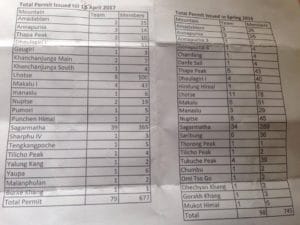 In late March, Kathmandu filled up with aspiring climbers. The Nepal government issued 371 permits for Everest. 70 used their prior permits, saving $11,000 on the cost of this year’s climb. Some spent all of that at the Kathmandu bars before they left for Lukla.
In late March, Kathmandu filled up with aspiring climbers. The Nepal government issued 371 permits for Everest. 70 used their prior permits, saving $11,000 on the cost of this year’s climb. Some spent all of that at the Kathmandu bars before they left for Lukla.
These days you can count on at least one Sherpa for every foreigner so that meant the south side was looking at least 750 humans going up and down, probably closer to 800.
Over on the Tibet side, figures are always hard to get. I was chastised by one western guide for using the wrong numbers (he read my post incorrectly) so he gave me the ‘right’ figures which I used only to come back and tell me I posted the wrong numbers (his numbers) and gave me newer ones.
Sigh, see I told you getting accurate numbers from the north is as easy as understanding Presidential Tweets … covfefe
Anyway, I digress. The north seemed to have about 136 foreigners and 170 support staff. Not nearly as many as I had thought.
It would be interesting to understand why the north side never regained the strong momentum it had back in 2006 and 2007. I have my theories and a lot has to do with if you are spending tens of thousands of dollars, you want some kind of assurance you will get to climb.
The big growth in climbers on the Tibet side was stopped cold when the Chinese effectively closed their side to take the Olympic torch to the summit in 2008. It has never reached the pre-2008 figures even with fights, serac releases and earthquakes on the south.
Perhaps with the Mountaineering Center under development in Tingre and helicopter rescue to be offered in 2018 for Everest north for the first time, the north will again see big numbers.
100 permits were issued for Lhotse, a stone’s throw from Everest. A few were looking to bag both peaks while above 8000 meters making Lhotse significantly easier – if you had any strength left from summiting Everest!
When you add all this up, there was over 1,000 people on and around Everest in 2017 – and that was a record. UPDATE: but the summits from Nepal was the second highest, not a record.
Trek and Drive

The usual trek and travel to base camp on both sides went smoothly. The Chinese played their usual games with permits delaying a few teams but those who climb regularly in Tibet know the drill well by now.
The dirt trails were filled with Zos, yaks, school kids, porters, locals – oh and climbers and trekkers – great news for the Khumbu teahouses.
The normal complaints emerged about crowded wifi access and difficulty in charging batteries – first world problems …
But by April 15, Everest Base Camp on the Nepal side and Base Camp on the rocky moraine at the foot of Everest’s impressive North Face filled up.
Early Icefall Route

The Icefall Doctors had worked hard to get the route thru the Khumbu Icefall in early this year – meeting a request from long time guides that an early open would help spread out the teams thus reducing any crowding.
So it began. Those on the north trudged up to Interim Camp for a night or two then onto Advanced Base Camp where they settled in for a bit.
Some teams like Himex and IMG on the Nepal side eschewed the Icefall to acclimatize on the 20,000 foot “trekking peak” Lobuche. This strategy eliminates at least one rotation through the Icefall but more importantly, reduces the time Sherpas and members spend there as did ferrying loads to Camp2 by helicopter this year.
Not usual, but still garnering publicity, a few seracs collapsed within the Icefall, covering ropes and knocking ladders back into the crevasses they crossed. Climbing paused while the Docs did their work and then climbing continued.
The Icefall was reported in good condition in 2017. This does not mean there were no collapses and some teams didn’t experienced delays but overall, it acted like a normal glacier.
But to be clear, climate change is impacting all the world’s highest mountains – and both sides of Everest. I assume one day many of the routes used today will become unclimbable on the 8000ers , thus providing an opportunity for a new generation of climbers to find new, safer routes.
Wind and Ropes
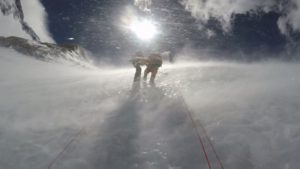
All was going well for the 2017 teams until the wind picked up in late April. Talk of an early summit – an annual tradition by those eager to get on top and out – was quelled.
The commercial expeditions, with responsibility to fix the ropes to the summit on the Nepal side seemed to stall out. They were stopped by the wind and there is a limit to how much a handful of people can do – even Sherpas..
Inexplicability a similar scenario was occurring on the north side. The Chinese Mountaineering Association, who has responsibility to fix from ABC to the summit, asked for help but said they would stop at 8300 meters, Camp 3. Teams huddled and the Indian team, Transcend Adventures, supported by Arun Sherpas took over. And did they ever.
Summits and A Record
On May 11 the Arun experts summited. They were the first of the season. Now with fixed the ropes set to the summit, a day later several Indian teenagers achieved their dreams with summits on the world’s highest peak.
In that push was a 47 year-old Sherpa woman, Lhapka Sherpa, who happened to summit for the 8th time – a female record. She reported a brisk breeze with frost nip on her cheek but the Transcend team said the wind gusted for a couple of hours but not a big deal.
And this set the tone for the next month on Everest.
Nepal Summit Ropes but Disappointments
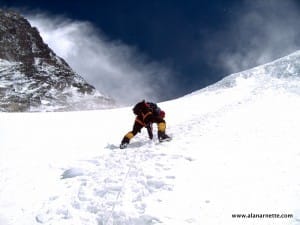 Back on the Nepal side, the Gurkha team saw a small window to summit but the Sherpas who had gotten the ropes to the Balcony, needed time to renew.
Back on the Nepal side, the Gurkha team saw a small window to summit but the Sherpas who had gotten the ropes to the Balcony, needed time to renew.
The Gurkhas with their Sherpas along with a couple of Sherpas from other teams fixed the route to the summit along the Southeast Ridge, thus declaring both sides open.
This was a classic example of mutual respect and teamwork across many teams.
A handful of aggressive climbers followed on their heels and were staged at Camp 2 and even Camp 3 ready to finish their climb early but the wind once again started to play an unforgiving game of serious chess.
David Tait and Kenton Cool with Himex literally begged the Big Boss to let them go for the top all the while knowing it was foolhardy at best. They relented when Brice said no and somewhat gracefully left the mountain, Nepal and went home.
Seriously is it there or not? – the Hillary Step

A few days after these summits, the same discussion from a year ago started back up: had the Hillary Step collapsed or was it just covered in snow?
The photos taken by early climbers this year were posted on social media. They went viral and the headlines screamed once again that the Hillary Step was gone!
Since 1953 climbers have climbed the Step almost every year and certainly since the early 1990’s. It is reasonable to think that during the last 64 years, heavy snowfall would have covered it up recreating a similar scenario. But it has never been reported to have “disappeared”.

But after a couple of weeks of the Hillary Step gaining global headlines (why newspapers around the world are intrigued by a mountain changing shape is beyond me), the Nepal authorities issued a strongly worded press release declaring the Step was fine, just covered in snow and would be back soon. 🙂
Actually, I do understand the upheaval as the Hillary Step is a piece of history on perhaps the most famous mountain route in the world.
I know that when I climbed House Chimney on K2 and the Hillary Step on Everest, I felt a bit of a tingle knowing I was walking in the footsteps of firsts. So I get it.
And, mountains move, change, eroded, collapse, grow – that’s what they do. So if it’s gone, thanks for the memories. But let’s wait to see what next year brings!
In general, the presence or absence of the Step seemed to have little impact on climbers this season. Some noted it was an easy snow ramp, other’s described it as a near vertical snow ramp – thus the reports we get from Everest climbers each year – but I never heard or read that it was easier or harder than in years past.
Weather Keyholes
The weather forecasters became more frustrated than a Brexit pollster. Their models were changing every 12 hours making the predictions out of date before they reached the mountain.
Instead of talking about weather windows of days, they talked about keyholes and openings of hours. Long time expedition leaders sat back and asked their members for trust and patience.
But not everyone was willing to wait. For some reason a few teams on the Nepal side wanted to summit in the second week of May, not the traditional third or even fourth. They risked the narrow keyholes and some summited, albeit with frostbite that was never reported on their websites.
One Mountain, Two Sides
Meanwhile those on the north were on a different mountain. The wind and snow stopped by an invisible wall of high pressure kept the north side downright balmy – at times.
Occasionally the winds would pick up and kiss the cheeks of a team or two but for the most part, they enjoyed finishing their rotations to the North Col, and many a tick higher, before returning to relax in the hot springs of the Tibet villages before their summit pushes.
Soon both sides were logging summit after summit, not the big numbers we are used to but a few here and there navigating the most fickle weather Everest veterans had experienced in years.
Khumbu Flu
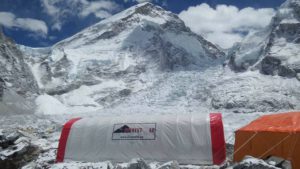 In the midst of uncertainty around ropes, weather and summit sorties’, climbers on the south side were getting sick – the flu to be exact.
In the midst of uncertainty around ropes, weather and summit sorties’, climbers on the south side were getting sick – the flu to be exact.
EverestEr was busy this year, treating well over 500 patients for the usual problems but reports started to come in about Everest and Lhotse climbers being seriously ill with the flu. The only cure was rest.
Many went back down valley to recover, odd because the flu was rampant down valley. But the body recovers better at lower altitudes so they didn’t have many options if they wanted to recover and get a chance to summit.
The weather and rope delays plus the flu started to have an impact on the numbers. Some teams went from nine to three members, other reported 20% attrition, some as high as 30% – and these were the big teams. Now instead of 800 humans on the Nepal side, it was more like 600 and history has shown that 20-30% of those will not summit.
The record year was quickly becoming just either big year on Sagarmatha.
Bad Behavior
In the third week of May, word came of the monsoons building in India that would bring heavy snow the the Himalaya by early June marking the end of a normal season on Everest. Climbers were eager to their summit bids in and tension was growing.
But something else was creating tension, perhaps more for the authorities than for the regular climbers. At least two cases were made public and perhaps there were more that stayed under the radar.
We had the one who climbed without a permit, knowing he was breaking not only the rules but also showing serious disrespect to the Nepal authorities. His social media posts flaunting his need to climb but having no money. He was caught and deported unceremoniously.
Another knew it was against the rules to traverse from one side to another, but declared that mountains have no borders. He also said he was climbing unsupported and without oxygen. He was wrong on all counts, caught and is currently being held in Kathmandu.
And there were stolen bottles of oxygen at the Lhotse high camp and at the South Col. Somehow the tenet of mutual respect and the climber’s code had take a hit by the actions of a few.
Nepal authorities again talked big but let the offenders away with a wrist slap, thus not discouraging future antagonist from making their own rules.
Spin

Some on the north told the world that conditions were perfect while others that same day posted clips of hurricane force winds.
Others made short cryptic posts and then went silent after the weekend of deaths. Families were worried, watchers confused and future members warned.
Social media has changed Everest climbing, and maybe climbing across the world.
Those who embrace the medium have become Cecil B. DeMille just waiting for that closeup. They maintain an image, a public persona that meets their audience, and sponsors, expectations. Weakness, heroics? Reality doesn’t matter in this reality show, just follow the script.
On Makalu, climbers argued if anyone reached the true summit – all played out on social media.
On Kangchenjunga, a lack of a few hundred meters of ropes stopped a summit bid. Blame was fast and furious on blogs.
On Lhotse, a fiasco around rope fixing flustered many, leaving them feeling like second class citizens to the massive Everest Industrial Complex. Again, self control was minimal as frustrations were aired on the Internet.
Those who did write honestly, openly and candidly; they helped bring a world that few experience to many who have a deep interest in Everest but will never step foot there.
To be sure, we are deeply appreciative of hearing the real story with real emotions regardless of the outcome.
Now or Whenever
Near the end of May, the winds finally decided the holiday was over in Tibet and hit that side hard. The SummitClimb team held on while their tents became shredded. They felt lucky to descend but then went right back up when the forecast called for a calm period. George Kashough captured the key moment at Camp 2:
On the south, all the commercial teams that demonstrated patience knew the time had arrived and almost in unison moved to Camp 2, Camp 3 the South Col.
Over a period of three to five days members and Sherpas made the summit in acceptable conditions.
The last week of May saw 300 summits adding to the 300 that had summited over the previous three weeks on both sides. 600+ for the season.
An Orderly Crowd
While the talk of record crowds encouraged fears of bottlenecks, and slow teams for the most part those fears never came true for the most part. A few climbers reported a bit of a wait at the traditional spots but nothing like in years past.
The summits on May 22 and 23 were orderly, climbers behaved. But the winds hit hard on the 24 stopping some at the Col in their tracks. If the organizers had planned for delays, they had extra oxygen and holed up for an extra day, but if not they quickly descended to base camp, their season over.
They picked back up a couple of days later.
NO Os

2017 seemed to have an unusually large number of climbers, many professionals, wanting to summit from both sides without the use of supplemental oxygen. About 11 tried and 5 succeeded.
Knowing that they would get cold easier and faster without oxygen, they waited as long as they could hoping for a tiny increase in air temperature but mostly of no winds.
May 27 and 28 was their chance. Actually they knew they were running out of time so in an uncoordinated movement, climbers on both sides began the long night fighting to stay alive.
In the end, most turned back as the wind and snow returned, albeit not with the same force, but enough that without the aids, the risks were high.
A few summited without oxygen returning to simply say it was hard. It may takes years to fully understand how hard it was and to hear the real story without the spin.
However, criticism of “style” emerged just after these attempts. The case study for 2017 being Dujmovits v. Ballinger.
You see for those who consider themselves professional climbers, or working towards a rare climbing goal – style matters. And those who ignore style (in the opinion of others) while treading in their domain, open themselves up to criticism from the other “elites”. This is an endless debate that detracts from the accomplishments of all but nonetheless is part of the sport, any sport for that matter.
From my perspective, props to all who attempted without Os, regardless of the result. If you summited, well done, if you turned back or started using Os, you showed good judgement and lived another day.
Run Kilian Run

As if summiting Everest without supplemental oxygen isn’t enough, Kilian Jornet proved he is not, um, average?
The young Spainard tired last autumn to establish a FNT (fastest known time) to run from the Rongbuck Monastery to the summit of Everest, and back, without O’s, fixed ropes or any form of human support. The weather stopped him so he came back six months later more determined than ever.
He arrived and saw the people and the conditions and moved to the sixth highest mountain, Cho Oyu at 26,970’ and ran to the summit plateau – for training, for fun, and for acclimatization.
He came back to Everest and watched the weather like everyone else. Then on Sunday evening, 21 May, at 6 pm, he started running on the normal route.
26 hours later he stood on the summit but was paying a big price. He had serious intestinal issues so, content with what he felt was a FNT to the summit from his starting point, stopped at ABC, 38 hours from the start.
Rumors leaked out that he was going to try again and sure enough on 27 May he took off from ABC making the summit in 17 hours, the round trip from ABC in a stunning 29:30 hours.
But Jornet’s accomplishment has attracted further questioning. He has posted no summit photos, no GPS track, no evidence beyond his word he summited as he was alone in the middle of the night.
The climbing community is keen to police itself so this will warrant further monitoring. But to be clear, this is an absolutely amazing feat, as he has done on many of the other world’s big peaks.
He joined the 2007 feat by Pemba Dorje Sherpa as being the only people to summit twice in the same week without supplemental oxygen. In 1996 Hans Kammerlander set the record by sumiting from ABC with no Os in 16:45. Kammerlander set a record also by doing the first ski descent of Everest.
Update 1 April 2018
Records, First, Bragging rights
This season felt like a contest of firsts. I have been inundated with message about a son, spouse, daughter, friend that was the first from here to go there or the oldest/youngest from that place …
Hey, congratulations to each and everyone but I have no way of knowing if it is true. My Bible is the Himalayan Database when it comes to Everest statistics, but even those fine folks have limits!
So in the interest of not acknowledging everyone, I won’t acknowledge anyone.
OK, I already feel guilty. There are a few I absolutely, positively, I think I know for sure to be what they claim … I think:
- Mollie Hughes – youngest Briton to summit from both sides
- Andy Holzer – 2nd blind person, Austrian who summited on north with Furtenbach Adventures
- Kami Rita Sherpa summited for the 21st time tying him with Apa and Purba Tashi Sherpa for most summits
- Lhapka Sherpa, 47, summited for the 8th time – a female record.
National Pride
National pride was in full swing this season but perhaps over the top in India and Pakistan. Rightfully proud of their performances this year – and I add my congratulations to the following, but …
The India press hailed the teenagers who summited “against the wind blowing at 280 km/hour and at the temperatures between minus 50 degrees to minus 60 degrees.” Um, that is 174 mph in 60 below zero fahrenheit temps – perhaps a bit of hyperbole.
By the way, the kids were “rewarded” with a cash bonus of US$4500 each. And we wonder why every poor child in India dreams of climbing Everest – superhuman and paid.
And in the category of interpretative records, India wins with the award for declaring a new record for “Indian Army Men Create History By Climbing Mt Everest Without Using Oxygen Cylinders” Actually four of their ten members summited without Os joining about 200 other climbers with the same accomplishment but the distinction apparently is “team”.
Turn Back

And then sadly, the unselfish work by his Sherpa went totally unacknowledged in this tribute to Pakistani Col Abdul Jabbar Bhatti who summited but ran out of oxygen.
His fellow Pakistani climber, Sa’ad Mohamed, is said to have given up his summit to help his teammate. The reality is they were rescued by Sherpas from Sherpa Khangri Outdoor.
In these reports there was no mention of Dawa Sange Sherpa who painted a very different version (read here) where Sange implored the Colonel to turn back when the weather turned bad before the summit, but he refused. Now both Bhatti and Sange have severe frostbite and will most likely loose fingers.
Sange reported:
Suddenly the weather started to turn bad and soon worse . Unfortunately my oxygen mask and goggles were frozed completely. The wind was too cold and strong, blowing all the new snow in the air that I could hardly see through my goggles. I realized that it’s more important to return back than heading up for summit of Mt.Everest as I was aware of the risk included. So, I requested my member to return back immediately for our safety but my member he refused my request because the Everest summit was very near and said he had paid a lot of royalty to climb Everest. So, he don’t want to return back without successful summit of Mt. Everest
But Bhatti has a completely different version claiming that Sange “instead of taking three bottled oxygen tanks, carried only one, resulting in a serious shortage of oxygen and he was forced to spend one night at a height of 8,500 metres without any oxygen”
He told the BBC when he arrived back in Pakistan, referring to Dawa Sange Sherpa as a porter:
The porter asked me to stand down when we were still not very high up the mountain. I asked him why he wasted my time and money if he couldn’t scale the mountain. When we reached closer to the summit, we ran out of oxygen and the weather was also becoming unfavourable. That’s when I told him we should go back down, but he insisted we should climb to the top.
In any event it is clear that Ang Tshering Lama Nima Gyalzen Sherpa, Jangbu Ang Mingma Chhiri Sherpa Pema Chirring Sherpa saved both men’s life.
Deaths, No Deaths, 7 Deaths

Continuing with the season press mysteries, in the middle of May, a story broke in the Kathmandu newspaper that four bodies were found at the South Col – they were part of a “new” guide services that had lost track of two members and two Sherpas.
It proved to be false but the story went viral as does every story with a headline of Everest and Death. I doubt there will many retractions, even from the newspaper that printed the story. The Ministry of Tourism felt the need to issue a clarifying statement and a wrist slap to journalists to verify their sources and stories before printing.
There are lessons here but I think they will fall on deaf ears.
7 Confirmed Deaths
The death count ended, we hope, at six climbers and one cook at base camp.
The 85 year-old hoping to regain his age record died at base camp. Yet another young Indian climber died near the Balcony after getting separated from his guide. An American doctor died, his body remains on Everest, the only one not retrieved this year. The independent Slovak climber not using supplemental oxygen died and a climber on the north side. See this page for their names and teams.
And after the season ended, another death was revealed, a Rai cookboy had died at basecamp. He died from a stroke/heart attack. All who died, all were tragic losses, proving the worse fears of their families. Devastating for teammates.
And one death shook the climbing world.
Ueli Steck

On April 30, it was reported that Ueli Steck had died from a fall off Nuptse. He was acclimatizing for a traverse of Everest and Lhotse.
The details will never be known as he was alone, in his element, probably climbing fast with minimal gear; out for his day climb that others would consider an expedition.
His loss echoed across the Western Cwm and the world.
Yes the Swiss climber was known for taking risks and even recently commented in an interview that he needed to change his style as the years were catching up on the 40 year-old.
His death left a hole in the fabric of the climbing world. Ueli showed what could be done. His confidence was contagious. His style was inspiring. His ability to relate to anyone he met, was legendary.
In a sport, this combination of talent, results and personality rarely comes along. He will be missed.
The Silver Lining, but No Summit Certificates for Sherpas?
For the first time in years, no climbing Sherpa, no Tibetan lost their life. And that is to be celebrated.
After large losses in recent years due mostly to natural disasters, the 2017 season proved kinder. Perhaps some of the lessons of those seasons or the training provided by the Khumbu Climbing center was paying rewards.
The Sherpa and support community work hard each year to help foreigners achieve their dreams. Thank you to all.
And I want to strongly ask the Nepal government to issue every Sherpa their rightful summit certificate for this year and all years.
The Truth
Wind, tragedy, misinformation, spin and summits – Everest 2017. In many ways it was a normal year. All of this happens every year with the headline that this year was different.
But this I know. For each person who summited, each one that waited weeks for their chance, each one who pulled their down suit hood over their face as the winds picked up then focusing on each step not willing to give up, turn back or slow down – that was what it takes to summit Everest.
A normal climb in a normal year.
Off Belay
 This wraps up my Everest 2017 coverage. I will continue to post about climbing news, take a deeper look at the toxic mix of inexperienced climbers and unqualified guides plus do my best to cover K2 starting in July.
This wraps up my Everest 2017 coverage. I will continue to post about climbing news, take a deeper look at the toxic mix of inexperienced climbers and unqualified guides plus do my best to cover K2 starting in July.
I want to thank you for your interest in my writings. This was my 15 year of covering all things Everest.
I want to remind my readers that I am just one guy who loves climbing. With 35 serious climbing expeditions including four Everest trips under my belt and a summits of Everest in 2011 and K2 in 2014, I use my site to share those experiences, demystify Everest each year and bring awareness to Alzheimer’s Disease.
My mom, Ida, died from this disease in 2009 as have four of my aunts. It was a heartbreaking experience that I never want anyone to go through thus my ask for donations to non-profits where 100% goes to them, and nothing to me. Any amount that is meaningful to you is meaningful to me. Select your own Alzheimer’s organization or I have suggestions at this link.
Climb On!
Alan
Memories are Everything

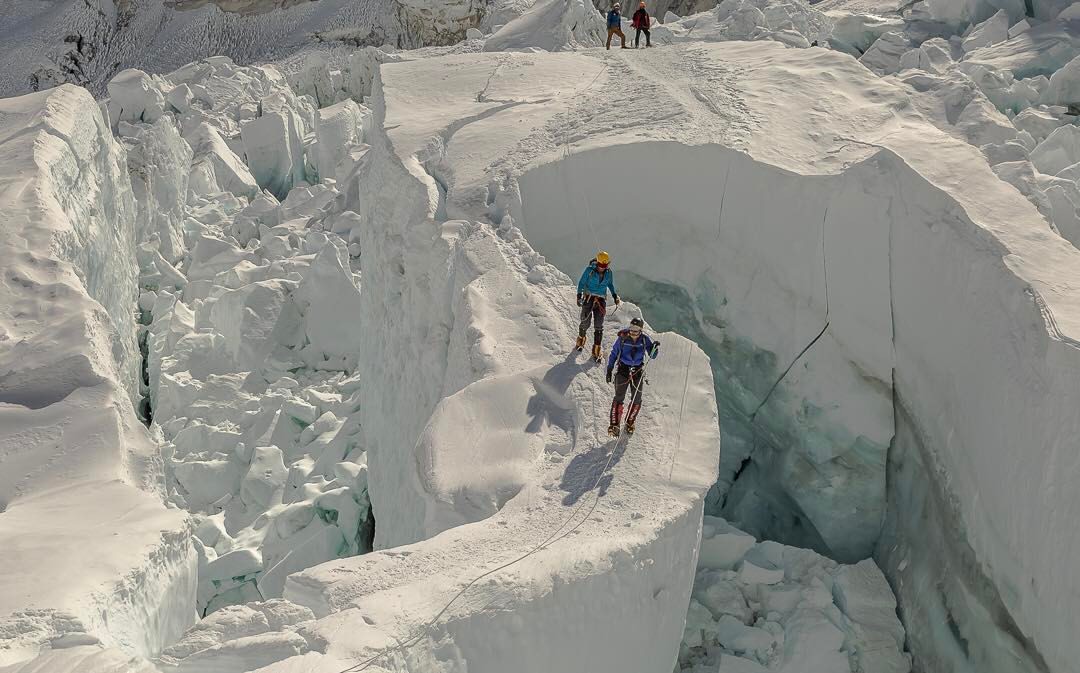



20 thoughts on “Everest 2017: Season Summary – A Mountain with Two Sides”
As usual, really interesting Alan. Thanks again Cheers Kate
One thing I am still learning from you, Alan, & most recently Blake Penson’s blog, A Few Days In, (especially his last 3 posts) is do not form an opinion about a guide too quickly. Otherwise, one just might end up dead wrong, either literally or figuratively.
Thanks again for great reading, and give Jake, the Wonder Dog, a good ole scratch behind the ears for me. ?
Carolyn
And there you have it. Bob’s your Uncle!
Thanks Alan – great as always.
🙂
I don’t understand the big deal about the Hillary Step. Mountains change all the time. I think it’s pretty clear that some collapse occurred. Just look at color changes. The old Hillary Step was obviously weathered and gray, and now the rocks have a yellow hue of freshly exposed rock. I think it’s obvious. JMO.
Also, thanks for yet another year of excellent coverage.
Keep healing,
Tammi
Hi Alan, Billi Bierling informed me that possibly also four members of an Indian Army expedition summited Everest w/o O2 (http://www.indiatimes.com/news/india/indian-army-men-create-history-by-climbing-mt-everest-without-using-oxygen-cylinders-323110.html).
Always love the coverage. You do great work for the climbing community and for raising awareness and funds for Alzheimers.research. I have and will continue to donate to my local research organization. Also, I heard a Birtish citizen summited on June 5th. Didn’t see it posted but could have missed it.
Very informative article. Thanks
Thank Alan. i am avid follower. However, I am sorely disappointed by your misguided conclusions about India and Indians. And worse, I even sense a bit of racism there. But that could be just my bitterness, because I never expected this out of you. This is regarding the section on ‘National pride’. The first link that you gave in that section doesn’t refer to the wind speeds at all. And even if there is a news item, it is simply a case of misreporting by some errant media house. The second link which talks about the feat of Indian army is not an official mouthpiece. The examples that you have given are simply examples of bad journalism and are plenty abound in your country as well. You have simply taken these bad examples of journalism and exhibited them as comments on national pride mixed with your sarcasm. This is deplorable. I expected better from an icon like you.
Thank you Saurabh,
I fully expected this reaction. While the success of the Indian climbers is not to be debated, the exaggeration by the Indian press is not to be dismissed.
I am very concerned that these type of overzealous articles only encourage the young Indians to dream of climbing Everest with no understanding of the dangers involved.
This year many Indian teenagers summited on the north side – successfully – and received “bonuses” from the government – no other country in the world does this now.
Yes I am worried about the young Indian climbers – and it is not racism – it is human concern.
The Indian army article was simply out of place and a stretch at best – you must agree.
I am writing this from Delhi .. I have all respect for all cultures, and Indian – and I don’t want to see any die out of mis-set expectations or bad press articles designed to promote success beyond their merit.
PS – to use racism as a ploy when you disagree with a point is weak at best ….
Thanks Alan. That clarifies. But I wish the article was as explanatory as your comment. The blame should be indeed put on the sensationalist media (and this is not national media or a representative of anything), but it should be called out in as many words. Maybe the heading of the paragraph should have been sensationalist media.
As for young Indian climbers, the per capita GDP of India is ~1,500 USD. A lot of us can’t ever dream of climbing Everest simply due to financial constraints. And no inspiring article or a paltry reward can help overcome this initial barrier. As for the teens that climbed through ‘Transcend Adventures’ this year, I believe they were sponsored by a special program run by the Govt with some objective in mind, and with all sorts of required training (done by Himalayan Mountaineering Association in India). In a democracy like India, a Govt. cannot afford to simply send young kids to the gallows. I would urge you to clarify & verify this with Transcend Adventures, and let the truth be out. I’d be happy eitherways.
P.S. – Apologies for the racism bit. As i said, it was probably my bitterness. I take it back.
By the way, the Indian government paid $92,000 for the retrieval of a young Indian’s body who died last year.
Thank you for your hard work in covering Mount Everest 2017. To show my appreciation I have made a donation to Alzheimer’s Association (the first time I have donated to an Alzheimer’s association, but most likely not the last.) I just wanted you to know your blog is having a positive effect in raising awareness of the burden of Alzheimer’s.
Thanks so much – you just made my day!
Thanks so much – you just made my day! and perhaps made the key contribution to find a cure….
Alan, thank you once again for the superb coverage of difficult subject matter.
Climb On…
Thank you Alan, for your most interesting, non technical, thought provoking coverage of the Everest season.
Thank you Alan, your coverage is more than anyone could ask for 🙂 I hope you continue doing the same in the coming years!
Do you know if any team is trying Everest in summer, autumn or coming winter?
Thank you Reinhardt. I don’t know of any teams for the rest of the year. Everest is rarely attempted in summer and winter but occasionally in autumn. I wouldn’t be surprised to see Nobukazu Kuriki try again in autumn.
There is K2 winter attempt planned by the Poles, lead by Krzysztof Wielicki, 67, that should be exciting if it happens.
Dear Alan , Thank You for the most exhaustive of coverage of Everest I have seen till date.
Your passion for this is truly unmatched. Much respect for what you do.
Regards Again.
Comments are closed.